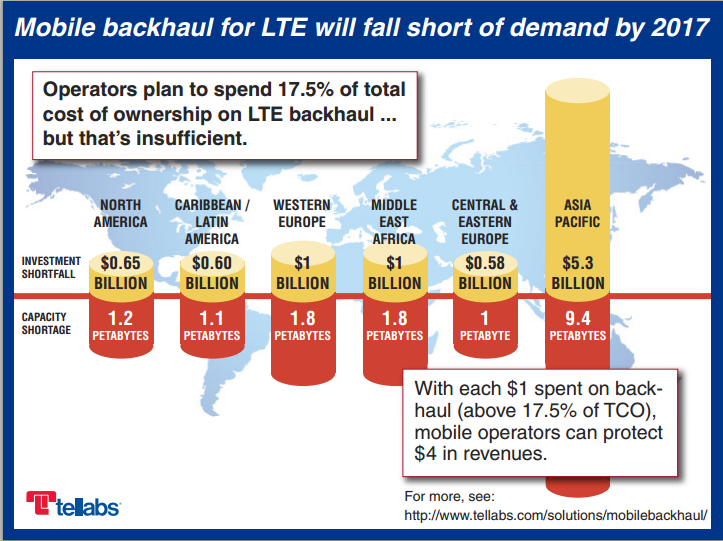|
|
|||||||||||||||
|
A recent Tellabs study highlighted a new concern for Operators as they upgrade their infrastructure to cater for the growing demand for high-speed LTE connection. The study predicts that by 2017, Operators will face severe shortfall in their capacity to meet demand due to insufficient investment in their backhaul infrastructure, which is expected to fall short by $9.2 billion.
Over the next 5 years, mobile backhaul will become increasingly complex. Operators will struggle to support multi-frequency heterogeneous networks and new bursty usage patterns. Current operator forecasts allocate an average of 17.5% of total cost of operations to backhaul investment, but investment at that level simply cannot meet user demand. The report finds that the cost of poor backhaul performance is greater than the investment to provide adequate backhaul.
“Addressing the new capacity crunch requires a highly strategic approach to backhaul,” said Dan Kelly, Tellabs CEO and president. “Operators who treat backhaul planning as a long-term, strategic investment opportunity to enhance customers’ Quality of Experience will produce higher revenue and profits. “In order to maximize overall returns, operators need to seriously consider issues beyond backhaul capacity and scalability. The watchwords for operators who take a smarter approach to future backhaul planning are flexibility, synchronization and end-to-end management — and that’s why Tellabs is enabling Self Organizing Network capabilities and Software Defined Networks in our mobile solution.”
|
|||||||||||||||





 “As many as 40% of mobile users list poor network performance as a reason for leaving an operator,” said Sue Rudd, Director, Service Provider Analysis, Strategy Analytics. “At today’s backhaul investment levels, operators could create a significant backhaul capacity shortage. This shortfall could diminish quality of service and, in turn, increase customer churn. Operators need to rethink their backhaul investments as they deploy small cells and LTE capacity.”
“As many as 40% of mobile users list poor network performance as a reason for leaving an operator,” said Sue Rudd, Director, Service Provider Analysis, Strategy Analytics. “At today’s backhaul investment levels, operators could create a significant backhaul capacity shortage. This shortfall could diminish quality of service and, in turn, increase customer churn. Operators need to rethink their backhaul investments as they deploy small cells and LTE capacity.”
















